David Murphy says there is something mesmerising about the colours of autumn.
The 63-year-old photographer, who runs his own gallery at Stanley on Tasmania’s North-West Coast, has been photographing landscapes and seascapes for decades. And he says when it comes to capturing magnificent images, the reds, oranges and yellows of autumn are hard to beat.
One of Murphy’s favourite places to take photos is at Cradle Mountain where the fagus – Tasmania’s only winter-deciduous native tree, which dates back to Gondwana times – is most spectacular.
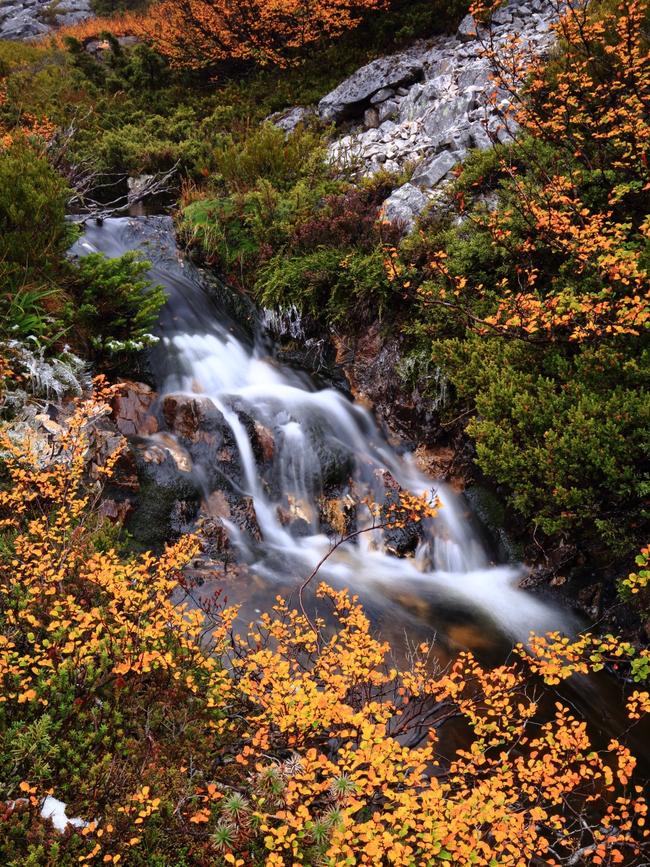
The turning of the tiny, crinkle-cut foliage of the fagus – from green to brilliant gold, rust red and orange – is a sight to behold in April, creating a majestic tapestry in Tassie’s alpine landscape. Colours reach a peak around Anzac Day, and typically continue to stay vibrant for about a month, attracting an influx of admirers to Cradle Mountain’s Dove Lake and Crater Lake.
Murphy has spent plenty of time battling the elements over the years, to get shots of the fagus in all its glory.
Usually he’s armed with his “best friends” – his two Canon 5D Mark III cameras – and at least one tripod. One camera usually has a shorter 16-35mm lens and the other a longer 200mm lens – so Murphy can easily capture different images without having to worry about constantly switching lenses, something which is particularly important when the weather is wild.
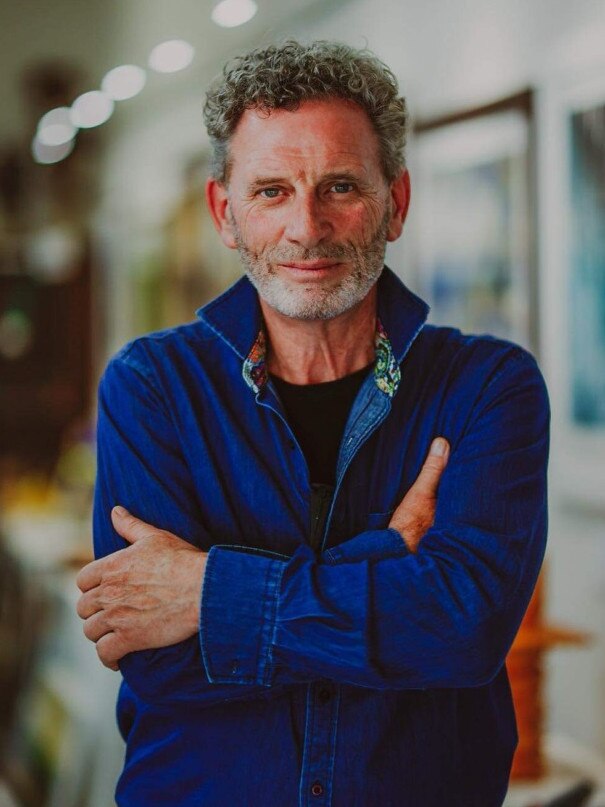
“I’ve been to other places,’’ Murphy says of photographing the fagus, which is also seen at Lake Fenton and Tarn Shelf in Mt Field National Park in the state’s South.
“But there’s nothing quite like what you find at Cradle Mountain. There’s just so much to see in that one area.’’
Murphy remembers seeing pictures of the fagus as a teenager growing up in the regional NSW town of Moree, an agricultural hub known for cotton and wheat growing.
The budding photography enthusiast, who never left home without his “cheap point and shoot” camera in his hand, remembers admiring the pages of a book, featuring images by famed Tasmanian photographer Peter Dombrovskis, in awe.

“There were beautiful fagus shots everywhere, and mountains in the mist,’’ Murphy recalls.
“And I thought ‘wow, wouldn’t it be great to go and see places like that and see the world like he saw it.
“Compared to the flat landscape of Moree, this was a whole new ballgame.’’
Fortunately for Murphy, the rugged Tasmanian wilderness wasn’t as far away as it seemed.
Murphy actually grew up in Tasmania – he was born in Smithton and lived there until he was 14, and fondly remembers spending Christmases with his family by the water at Ulverstone.
But when his parents split up, he moved with his mum and his brother to Moree, to be closer to extended family.

“I was going back to Tasmania every year to see my dad in Smithton and I loved going back to Tassie,’’ Murphy recalls.
When he was about 15 or 16 he remembers bringing a camera with him to Tasmania. He can’t remember exactly where it came from – he suspects it was a gift from his mum – but he clearly remembers the photos he was able to take with it.
He recounts being on the hill at Marrawah, looking across to Green Point Beach, and photographing hay bales scattered across the grass, underneath a bold blue sky.
He also fondly remembers taking photos of the landscape surrounding his dad’s shack at Couta Rocks, a small fishing settlement on the West Coast.
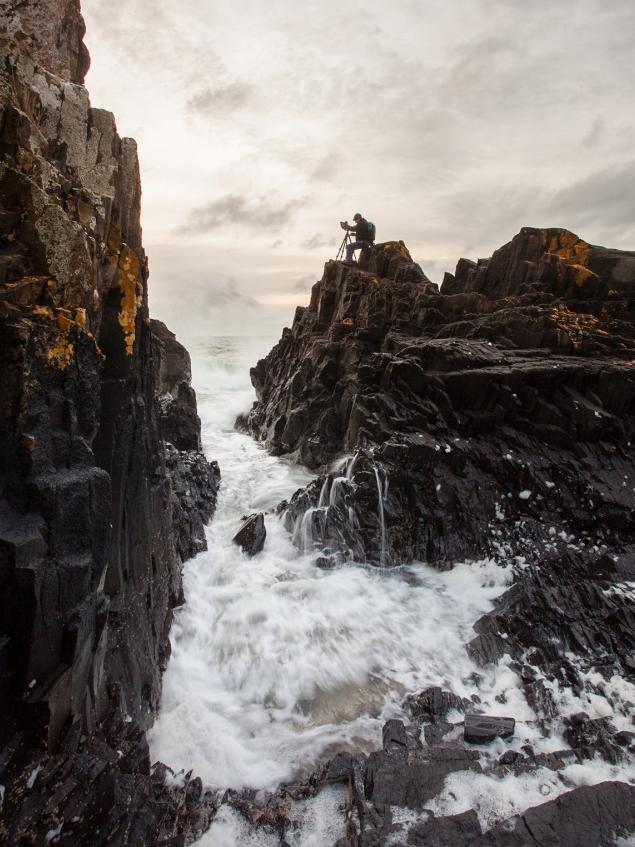
Eventually Murphy upgraded to his “first sensible camera” – a Pentax K1000 SLR.
“That was a lot of fun,’’ Murphy recalls. “Learning how to use the camera. I didn’t really understand what I was doing so I thought the best thing would be to keep a journal.’’
He made careful notes about each photo he took, recording F-stops and other essential information, so when he processed each roll of film he could look at the prints and compare notes to better understand what worked, and what didn’t.
He remembers winning lots of awards at the Moree Show – it wasn’t lucrative “50 cents here, $2 there” but it was a way for Murphy to showcase his work.
Murphy settled in Moree, and got married and had three children.
But that marriage ended, and when his dad’s second wife died, he headed to Tasmania to help look after his dad, who had Alzheimer’s disease.
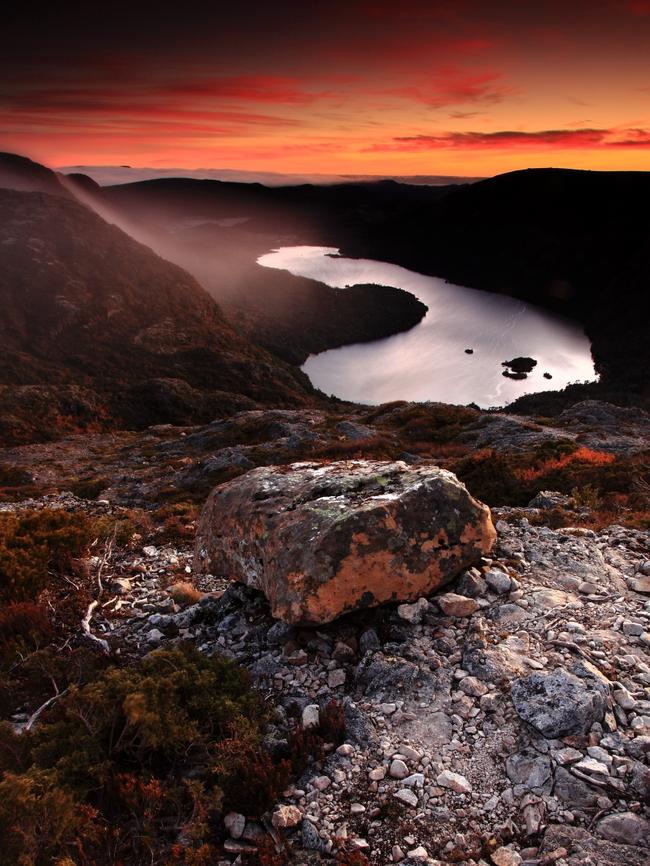
“Dad couldn’t cook an egg without blowing up the kitchen,’’ Murphy recalls.
“So I came down to see dad from Moree.’’
He soon decided he’d stay in Tasmania, so he rang his boss in Moree, where he’d worked as an inspector weighing overloaded vehicles for close to 10 years, and quit.
That was about 25 years ago, and Murphy says he hasn’t looked back.
He spent about 10 years working shift work, as a storeman at McCain Foods at Smithton.
And it was here he got to know Garth Smith, a fellow storeman, who also had a passion for photography.
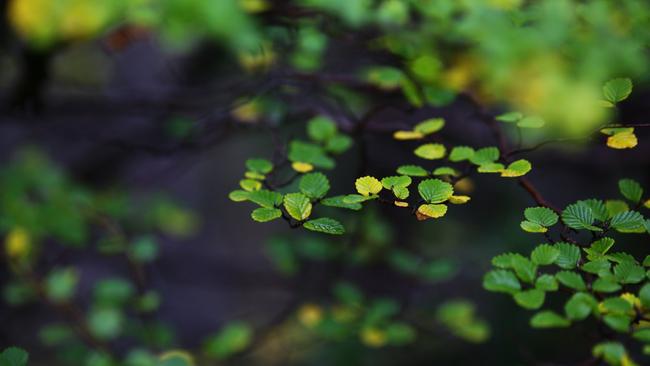
When they were not working, the two men would often head out on photographic trips,
“We used to go shooting all the time,’’ Murphy recalls.
“Almost every day. We’d go morning and evening, with new digital cameras … we shot everything and we did that for ages, for years and years.’’
So when McCain announced in 2009 that it would close its vegetable processing plant at Smithton resulting in 200 permanent and casual staff losing their jobs – including Murphy – he decided to see his redundancy as a blessing and forged a career as a photographer and gallery owner.
“I was getting pretty good at (taking photos),’’ Murphy explains.
“I thought maybe if I came to Stanley and found a house that could be a gallery then I could have a crack at that. I didn’t know if that would be a sensible idea or not.’’
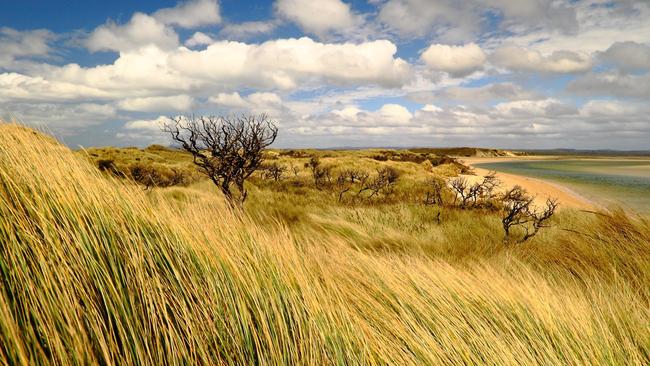
But he knew there was a market for his images – as he’d been selling his framed photographs at a coffee shop in Smithton and they were so popular he was struggling to keep up with demand – so he decided to take the plunge.
“That just gave me the energy I suppose, to think ‘I might be able to do this’,’’ Murphy recalls.
“I thought if I could easily sell 20 pictures in a little coffee shop then what if I had my own gallery. So I decided ‘What the hell, I’ll give it a shot and see what happens’ and it paid off.’’
That was about 14 years ago. Murphy admits it wasn’t easy in the beginning, but slowly he built up the business, with his work attracting more and more attention. After about four years he moved to a more prominent location in Church St, next door to a coffee shop in the heart of Stanley, where his Cow and Calf Art Gallery is now thriving, with Murphy showcasing his own work along with the work of 20-30 other local artists.
The town has become a hotspot for tourists, earning a name for itself as place steeped in natural beauty and history, with a romantic streetscape of colonial buildings and quaint cottages. Of course there’s also the scenic Nut – an ancient volcanic plug that rises 152m above the sea – and the town is considered a gateway to the Tarkine/takayna wilderness.
“It has always been a good place to be with a camera and a gallery,’’ Murphy says.
“When I was a kid, mum or dad would go for a drive, and dad would usually be the one who would bring us over to Stanley, he used to know a few of the fishermen here. It was a little rundown town at the time but Stanley is just a beautiful area now, it’s a wonderful little town. Even on the quietest days there are still quite a few tourists. And we’ve got three or four lovely beaches around us. It’s a fabulous thing to come to work here every day.’’

And of course it’s those lovely beaches – along with other natural wonders in the area – that have fuelled Murphy’s passion for photography over the years.
And while he’s captured countless images in various parts of Tasmania, particularly in the state’s North-West, Murphy says immersing himself in nature has also been healing.
He details a “rough period” where both his parents died, and he also recounts the heartbreak of having his four-year-old daughter die in his arms after a battle with cancer.
Murphy’s two other children are now aged in their late 30s.
Murphy considers Tasmania to be “a healing place” and says being close to nature – particularly near the sea – has been life-changing for him.
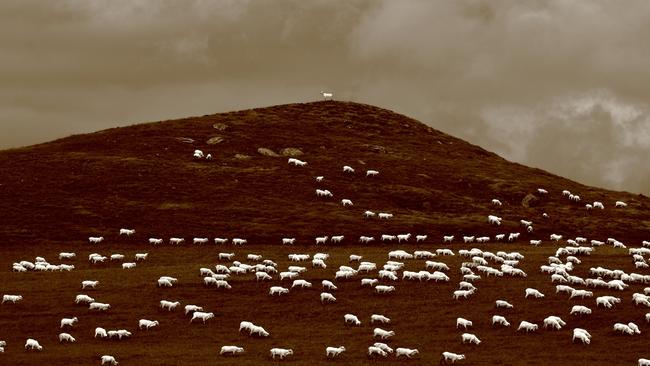
“I have just always loved being near the sea,’’ Murphy explains.
“It’s never going to be a problem for me to live in a place like Stanley, surrounded by water except for where you drive off the inlet. Where I live I can hear the sea banging away at Godfreys Beach. I spent all those years at Moree, and I could probably count on my hands how many times I got to the coast over those 20-odd years, the only other time I was near the water was when I came back down to Tassie to see Dad.’’
On his website, Murphy writes that the sea was his “distant friend” for 20 years but always held a special place in his heart and played a part in his decision to settle in Tasmania.
He says from “the scents and sounds of salt and kelp, of gulls and terns, of rhythmic thumps signalling change” to the “bristling, busy wind … slicing down granite corridors and whipping over runnelled sands” and the “sheen of translucent stillness”, there is so much that fascinates him about the ocean.

He likens the tidal ebbs and flows of the ocean as being indicative of the ups and downs of life.
“The sea symbolises the turmoil and peace of my own life,’’ Murphy says.
“She is an ever-changing, moody muse, my footprints on her sands reminding me to never be distant again.”
It was actually on a crisp autumn evening, by the sea, that Murphy had a chance encounter with a couple visiting Tasmania from Ireland. During their conversation, the couple explained that the name David Murphy had a Gaelic equivalent and a deep meaning: ‘Beloved of the sea’.
“This definition made perfect sense to me, having felt an indescribable and unwavering drawing to the sea and its coastline my whole life,’’ he says.
That discovery led him to publish a book of photographs, narratives and poems called Beloved of the Sea.
Some health problems in recent times – combined with the busy nature of running a small business, which involves Murphy doing all his own printing and framing as well as welcoming customers into his gallery – have meant he hasn’t been out in the elements taking photographs as much as he’d like.
But he’s hoping to visit Cradle Mountain in April to photograph the fagus.
In the meantime, the self-confessed larrikin is always happy to chat to customers about his exploits and have a bit of fun.
“I love what I do,’’ he says.
“I thoroughly enjoy it and every day is just a day making people laugh, and having a laugh with them. When people come into the gallery I say it’s nice to see them, and talk to them, it doesn’t matter if they don’t buy anything.
“And I always act the goat somehow or another. Life’s too short to not laugh hard I reckon, I do everything with a laugh. My daughter Jess was in my arms when she died, she was four years old and she looked up at me and said ‘I’m going now, Dad’ … I think it’s important to make people’s lives happier by being fun.’’
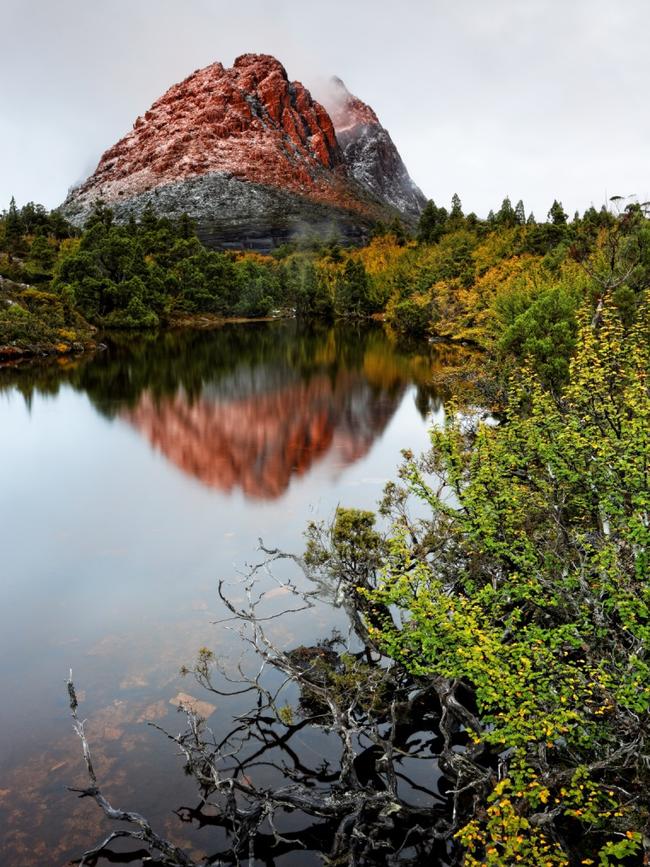
Photography helps bring that extra bit of fun into Murphy’s life, as he finds great joy in playing around with different filters and techniques to capture the beauty of Tasmania’s landscape in new and exciting ways.
“There’s something special about looking in the back of that camera and going ‘wow’,’’ Murphy says.
“And getting excited by it, and thinking ‘now what can I do to make it even better’. Any particular moment can be a real blast of creation. It just gets into my heart, it’s part of me, it actually makes me a bit teary just thinking about it, it really is a passion. The best thing about Tassie – particularly the area I am in, where I’ve been for most of my life up in the North-West and Cradle Mountain – I could hang around those areas forever and still get something different all the time.’’
DAVID MURPHY’S TIPS FOR TAKING GREAT PHOTOS
Choose your time of day wisely: “When I’m at my best I get up when it’s still dark in the morning, and I get somewhere before it gets light,’’ Murphy says. “I’ll walk down to the beach and be there when it’s semi-dark, watching what the light and the tide are doing. And the same applies for late afternoon. Get there when there’s a bright sky and start to see how the light changes as the day ends.’’
Adhere to the rule of thirds: When composing your landscapes and seascapes, think about imaginary horizontal and vertical lines running through your images. Place your subject in the left or right third of the image leaving the other two thirds more open. Murphy typically likes to dedicate one third of his image to the sky and two thirds to the rest of his landscape. This isn’t an exact science, but is a good starting point for structuring images. “It really inspires me, even when I don’t have a camera in my hand,’’ he says, “I look at landscapes and can see how you could structure that in thirds quite easily’’.
Use leading lines: “I think this is the best thing you can do for any potential photographer … I believe seriously in the notion of leading lines,’’ Murphy says. Leading lines are a compositional technique where man-made or natural lines lead the viewer’s eyes through a photograph to the subject or the heart of the image. He says lines might come in from one side of an image, or both, or all four corners. Lines might be created by frothy water running back into the sea, by tree roots, by a piece of driftwood, or some interesting cloud formations.
Be prepared for all weather conditions: “I spent $700 or $800 on a good coat some years ago and it was the best thing I ever invested in,’’ Murphy says. “The best time to photograph the fagus is April and it’s a wet environment, you’ve got to be prepared. Buy the best clothing you can afford.’’ Decent shoes are also a must and he always packs spare socks in case his feet get wet. If you’ve got the right clothing you can stay out for longer, and will be more likely to get the best shot.
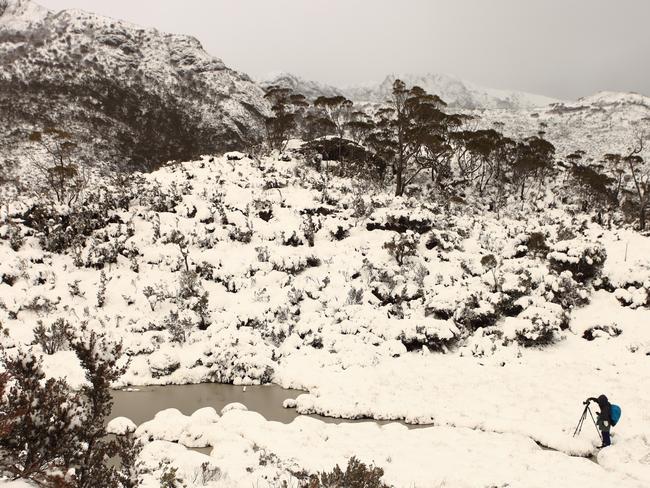
Play with your camera’s settings: “I don’t use Photoshop,’’ Murphy says. He uses Canon software to do basic edits like getting rid of dust spots, but mostly uses filters and settings within his camera (like shooting multiple exposures which can be merged into a single image) to create stunning photographs. He says using different filters and lenses and playing around with aperture and depth of field are good places to start, to capture colour and movement within images, particularly when incorporating things like clouds or water.
Make the most of the autumn colours: “The appeal of the fagus is that the colours are great … all the reds, yellows and greens,’’ Murphy says. He likes using a long lens to focus on a deep part of a fagus bush and then keep the background soft. Cradle Mountain and Mt Field National Park are two of the best places to see the turning of the fagus from late April to late May. For tips on planning your trip visit parks.tas.gov.au
•

Add your comment to this story
To join the conversation, please log in. Don't have an account? Register
Join the conversation, you are commenting as Logout
New series shines light on muttonbirding, wild Bass Strait island
This powerful landmark series, set against the raw beauty of Great Dog Island, is a deeply personal reckoning with heritage, fatherhood and the fragile continuity of an Indigenous tradition
Check out our picks of the best bites of the dark delights
If you haven’t been yet, there’s still time to catch Winter Feast – Tassie’s tastiest food ritual returns this Thursday. Here are a few delectable treats I highly recommend, writes Alix Davis